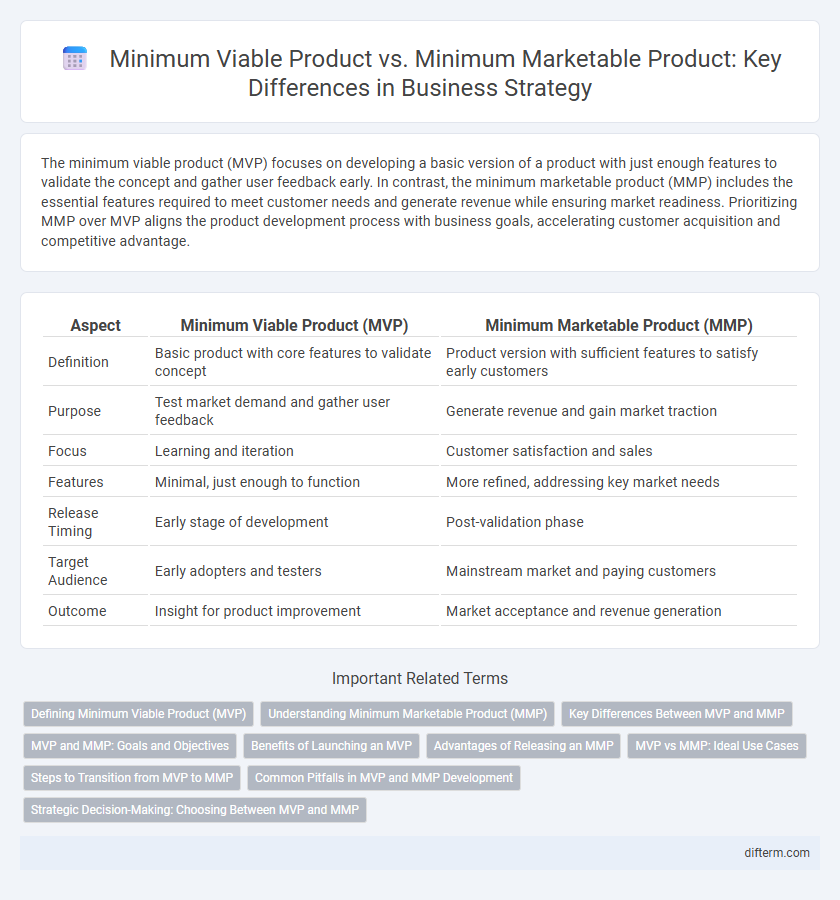The minimum viable product (MVP) focuses on developing a basic version of a product with just enough features to validate the concept and gather user feedback early. In contrast, the minimum marketable product (MMP) includes the essential features required to meet customer needs and generate revenue while ensuring market readiness. Prioritizing MMP over MVP aligns the product development process with business goals, accelerating customer acquisition and competitive advantage.
Table of Comparison
| Aspect | Minimum Viable Product (MVP) | Minimum Marketable Product (MMP) |
|---|---|---|
| Definition | Basic product with core features to validate concept | Product version with sufficient features to satisfy early customers |
| Purpose | Test market demand and gather user feedback | Generate revenue and gain market traction |
| Focus | Learning and iteration | Customer satisfaction and sales |
| Features | Minimal, just enough to function | More refined, addressing key market needs |
| Release Timing | Early stage of development | Post-validation phase |
| Target Audience | Early adopters and testers | Mainstream market and paying customers |
| Outcome | Insight for product improvement | Market acceptance and revenue generation |
Defining Minimum Viable Product (MVP)
A Minimum Viable Product (MVP) is a development technique in business focusing on building a product with just enough features to satisfy early adopters and gather validated learning for future product development. MVP aims to reduce time to market and development costs by releasing a basic, functional version of a product to test assumptions and customer reactions. This approach contrasts with a Minimum Marketable Product (MMP), which includes sufficient features to be marketed and sold successfully.
Understanding Minimum Marketable Product (MMP)
The Minimum Marketable Product (MMP) focuses on delivering the smallest set of features that provide value to customers and generate revenue, distinguishing it from the Minimum Viable Product (MVP), which primarily tests product hypotheses with minimal functionality. An effective MMP aligns closely with market needs and prioritizes usability and customer satisfaction to accelerate time-to-market and maximize return on investment. Identifying the MMP involves analyzing customer feedback, competitive products, and revenue potential to refine features that ensure market readiness and business viability.
Key Differences Between MVP and MMP
The minimum viable product (MVP) is designed to test core functionalities with minimal features to validate assumptions and gather user feedback efficiently. In contrast, the minimum marketable product (MMP) includes enough features to satisfy early customers and generate revenue while maintaining a competitive advantage. MVP focuses on learning and iteration, whereas MMP targets market readiness and customer acquisition.
MVP and MMP: Goals and Objectives
Minimum Viable Product (MVP) focuses on delivering the core functionality necessary to validate a product idea and gather user feedback quickly, minimizing development costs and time. Minimum Marketable Product (MMP) aims to provide a complete set of features that satisfy early adopters and generate initial revenue, ensuring the product is market-ready and competitive. MVP's objective is learning and iteration, while MMP targets market entry and customer acquisition.
Benefits of Launching an MVP
Launching a Minimum Viable Product (MVP) enables businesses to validate their core value proposition with minimal resources, reducing development costs and time to market. Early customer feedback from an MVP guides iterative improvements, enhancing product-market fit and increasing the likelihood of commercial success. This lean approach minimizes risk while maximizing learning, allowing companies to allocate resources more effectively and attract early adopters.
Advantages of Releasing an MMP
Releasing a Minimum Marketable Product (MMP) allows businesses to deliver a refined, customer-ready solution that addresses core market needs, enhancing user satisfaction and driving early revenue generation. Focusing on essential features increases market competitiveness by enabling faster feedback loops and more targeted marketing strategies. This approach reduces development risks and maximizes resource efficiency by prioritizing value-driven functionality over minimal feasibility.
MVP vs MMP: Ideal Use Cases
Minimum Viable Product (MVP) is ideal for early-stage startups aiming to test core assumptions quickly and gather user feedback with minimal resources. Minimum Marketable Product (MMP) suits businesses ready to enter the market with a more polished, feature-rich offering that addresses specific customer needs and drives initial revenue. Choosing MVP supports rapid iteration and validation, while MMP focuses on market readiness and customer adoption.
Steps to Transition from MVP to MMP
Identify key customer needs and collect feedback from the Minimum Viable Product (MVP) to refine features that drive user engagement. Prioritize development efforts by integrating scalable, market-ready functions and enhancing user experience to meet Minimum Marketable Product (MMP) standards. Validate the improved product through targeted market testing and analytics to ensure alignment with business goals and customer demand.
Common Pitfalls in MVP and MMP Development
Common pitfalls in minimum viable product (MVP) development include overbuilding features that exceed initial user needs, leading to wasted resources and delayed feedback cycles. In minimum marketable product (MMP) development, underestimating market readiness or customer expectations results in poor adoption and compromised competitive advantage. Balancing feature scope with validated user requirements and market demands is crucial to avoid these development pitfalls and ensure product success.
Strategic Decision-Making: Choosing Between MVP and MMP
Strategic decision-making between Minimum Viable Product (MVP) and Minimum Marketable Product (MMP) hinges on balancing speed to market with customer value delivery. MVP focuses on rapid validation of core functionalities to gather user feedback and reduce development risks, while MMP emphasizes launching a product with sufficient features to satisfy early adopters and generate initial revenue. Choosing MVP supports iterative development and market learning, whereas selecting MMP aligns with capturing market share and achieving a competitive advantage early.
minimum viable product vs minimum marketable product Infographic

 difterm.com
difterm.com